Great Dayton Flood Historic Marker
Introduction
Text-to-speech Audio
Images
Main Street during the flood
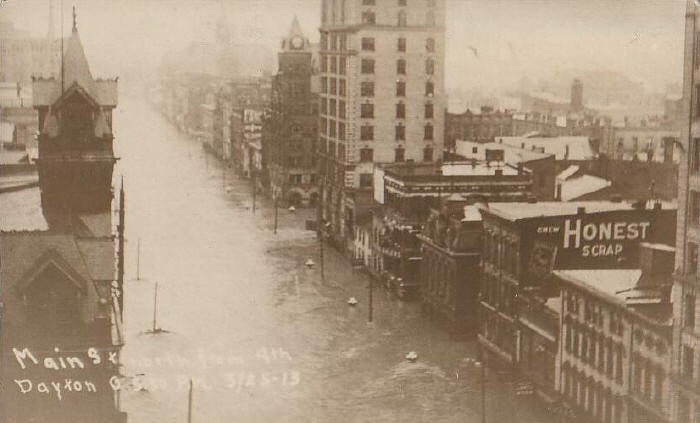
Aftermath of the flood
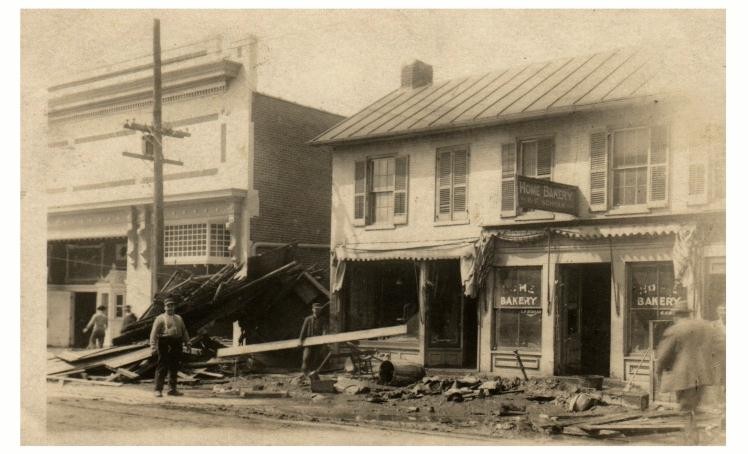
Horses underwater during the flooding
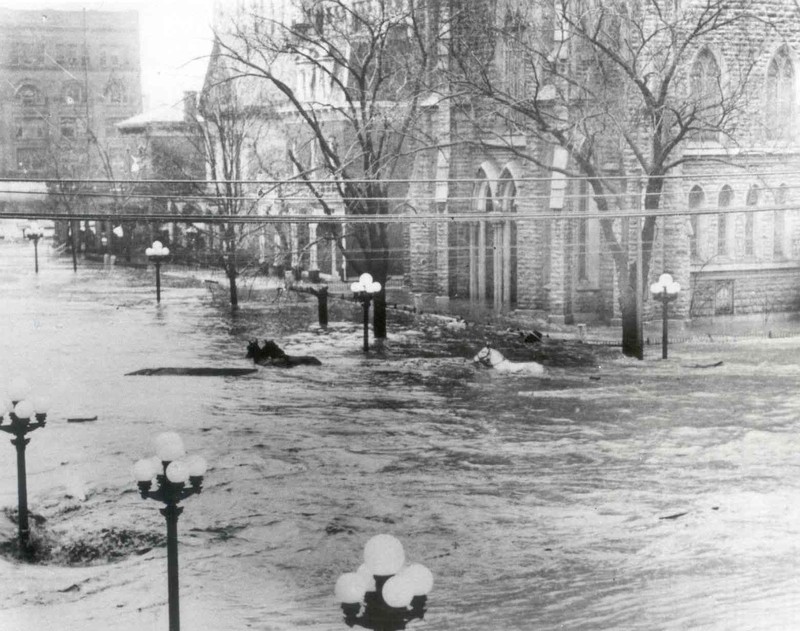
NCR rescue boat
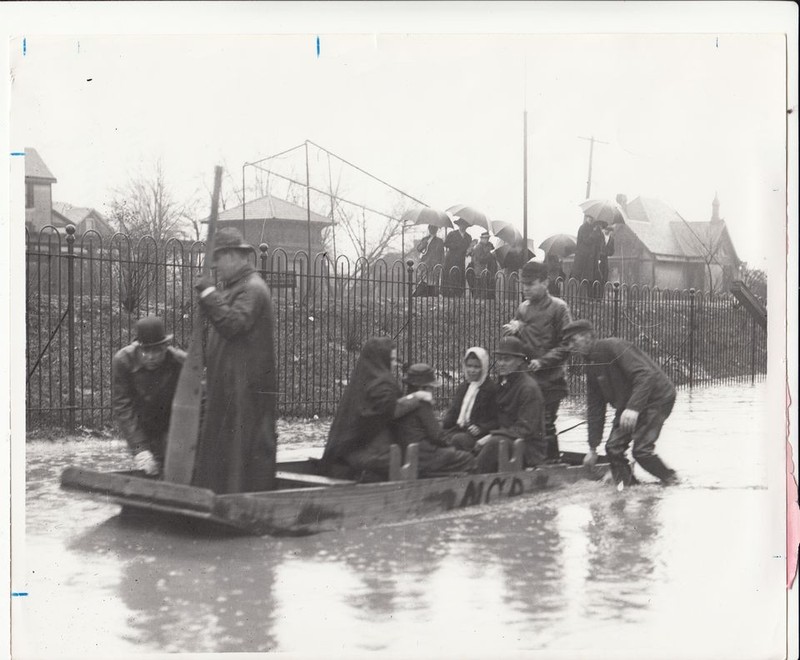
A street in Dayton after the floodwaters receded
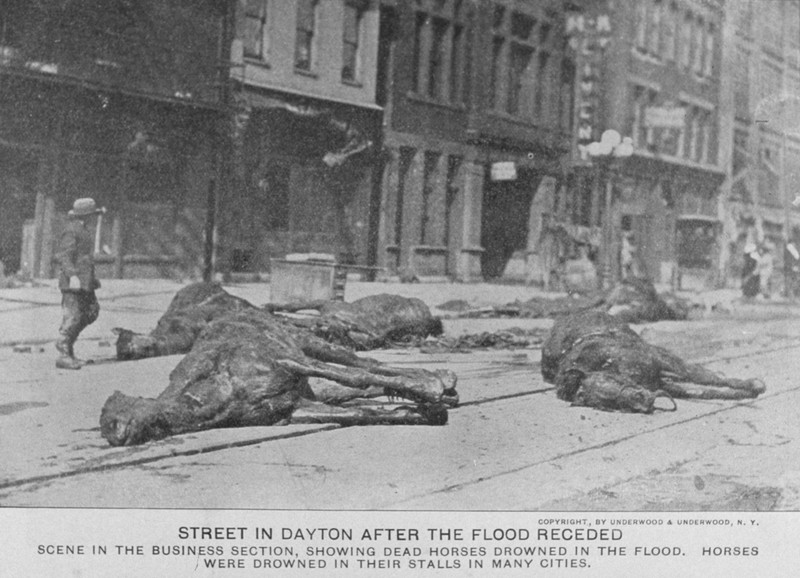
The Great Dayton Flood of 1913 by Trudy E. Bell. For more information about this book, please click the link below.
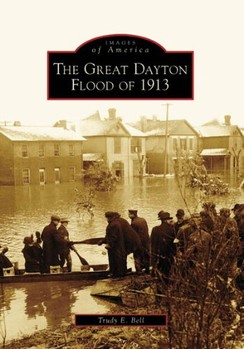
This flood level marker is located on the side of the Edwin Smith House in downtown Dayton.
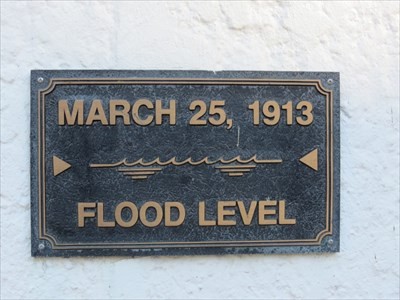
Backstory and Context
Text-to-speech Audio
When settlers arrived in present-day Dayton, local Shawnee chiefs warned them about the valley’s predisposition for torrential flooding. In fact, throughout the 19th century, there were major floods in 1805, 1828, 1866, and 1898; however, none were as devastating and destructive as the Great Dayton Flood of 1913. This flood would later be known as the greatest disaster in Ohio history.
The Miami Valley
Dayton’s success as a Midwestern settlement in the late 18th century was, in part, due to its abundant resources, fresh water, quality soil, and transport via the several river channels. When settlers first arrived in present-day Dayton after traveling up the Miami River from Cincinnati in 1796, some considered calling the new settlement “Venice” since it stood at the confluence of the Miami River and its tributaries, including the Mad River, Stillwater River, and Wolf Creek. As the Great Miami River watershed led into its tributaries, the area was also known to flood nearly every other decade. Since the founding of Dayton, major floods occurred in 1805, 1828, 1866, and 1898.
Timeline of the Flood
The Great Dayton Flood of 1913 was essentially caused by a series of exceptionally strong late-winter storms that hit the entire midwest in late March (causing the so-called Great Flood of 1913 throughout several states). On Good Friday, March 21st, the first storm hit Montgomery County, and though there was little rain, temperatures dropped and high winds blew. By Easter Sunday, torrential rains arrived to the entire Ohio River Valley, and in the next four days, the storm dropped a record-breaking three months of normal rainfall within a four-day span. On Monday, March 24th, the rivers were rising significantly. Due to the cold weather over the weekend and the immense rainfall (8 to 11 inches), the soil became so saturated that 90-percent of rain was running off into the Miami River and its tributaries.
Tuesday morning, police received word that the levees were failing, due to the increased pressure caused by the overflowing rivers. Soon after, the police started the warning sirens and alarms, warning of a coming flood. City Engineer Gaylord Cummin reported that the water was flowing at a rate of nearly 100,000 cubic feet per second, and by 6:00 am that morning, the water flowing over the levees started appearing in downtown Dayton’s streets. Derbies built up under the city bridges held back the water, effectively diverting them into town as well. Then, by 8:00 am on Tuesday, the levees on the south side of the business district failed and heavy amounts of water flooded into the town. Just after lunch that day, the water in the downtown area was 10 feet deep.
People escaped as best they could, though thousands more remained marooned in their homes. The water rushed too fast to permit swimming, and many boats capsized. To escape, some reports showed people walking across power lines. Soon, the water wasn’t the only problem, as opened gas lines caused by the flood took fire and engulfed several blocks in the downtown area. On Wednesday, the water reached a crest of 20-feet and a gas explosion rocked downtown near the intersection of 5th Street and Wilkinson.
Already Governor James M. Cox was calling the National Guard into the flood-affected areas, but they were slow to arrive. Fortunately, founder and president of the National Cash Register Company (NCR), John H. Patterson, had the resources and capabilities to provide immediate relief to flood victims. Soon after the floods arrived, Patterson and NCR employees built over 300 rescue boats to save people from rooftops and the upper stories of buildings. The NCR factory on Stewart Street became a shelter providing food, lodging, and medical care. Other NCR facilities stood as makeshift morgues, temporary campgrounds for the homeless, and newsrooms for journalists and photographers.
Aftermath
As the floodwaters retreated, they left unprecedented destruction in their wake. A total of 360 people died, business activity completely stalled, there was a large shortage of food, and upwards of 65,000 people were displaced. The current of the flood caused many buildings to moved off their foundations. Over 20,000 homes, however, were destroyed. Damage was estimated at $100 million.
The Great Dayton Flood empowered citizens and city officials to make immediate changes, determined to never experience a flood of such intensity again. By March 27th, 1913, Governor Cox delegated the Dayton Citizens Relief Commission, which raised $2 million to fund flood control efforts. With more than 50 engineers working with the Morgan Engineering Company, plans were developed to handle 140-percent of the floodwaters from the 1913 flood. Within the following year, Governor Cox began working on the Vonderheide Act, which gave the government the possibility to identify conservancy districts for flood control. Although quite controversial, the subsequent Ohio Conservancy Act formed the Upper Scioto Conservancy District and the Miami Conservancy District.1
